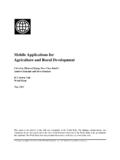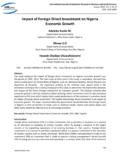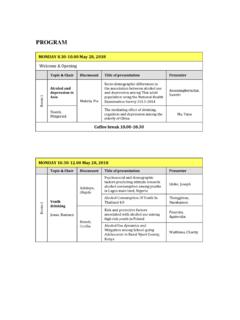Transcription of An analysis of cultural impact on international …
1 Journal of Management and Marketing Research An analysis of cultural , Page 1 An analysis of cultural impact on international business performance via foreign market entry mode: case of South Korean MNCs Cheong-A Lee Pusan National University Ho-Yeol Bang Pusan National University Jong Wook Ha Columbus State University Joo Young Lee The University of West Alabama Young Hee Yun Kim Tuskegee University ABSTRACT Research on the entry mode of multinational companies (MNCs) to a new market has been one of the major topics in the international business, and the cultural factor has been regarded as one of the major factors to explain the entry mode selection of MNCs.
2 Based on the development on the cultural factors on entry mode, MNCs can enter a market with joint venture or a wholly owned subsidiary. This study tries to extend the analysis on the cultural factor by investigating whether a MNC prefer a new establishment of business or an acquisition of an existing local firm when the MNC enters the market with a wholly owned subsidiary. Also this study tests whether a MNE with more global experience has been less affected by cultural difference from a target market. The results from the empirical analysis on the first hypothesis show that a MNC prefers a new establishment of business when it enters a market as a wholly owned subsidiary.
3 The second hypothesis is rejected with the empirical tests, and impact of cultural difference on performance of a MNC is not affected by the level of global experience of the MNC. Keywords: international Business, Cross- cultural Management, Foreign Entry Mode, Foreign Direct Investment, cultural Difference, MNE Journal of Management and Marketing Research An analysis of cultural , Page 2 INTRODUCTION Foreign direct investment has been one of the most important subjects in international Business (Javetski, Edmondson and Echikson, 1996), and choosing the right foreign market entry mode will determine the success of foreign direct investment (Geringer, Beamish and deCosta, 1989).
4 While traditional approaches to explain the market entry strategies of multinational enterprises (MNEs) use the economic and management factors, recent studies have found the strong effects of cultural factors on foreign market entry strategies. Most studies on cultural effects have been made on strategic alliance and joint ventures with various factors such as credibility between partners (Parkhe, 1993; Tiessen, 1997; Tyler and Steensma, 1998, Weaver et al., 2000), cultural difference and control levels (Kogut and Singh, 1988; Erramilli and Rao, 1993; Padmanabhan and Cho,1996; Annad and Delios, 1997), and ownership structure of foreign subsidiaries (Erramilli, 1996; Hennart, 1998).
5 With the use of various factors described above, most studies on cultural factors have been made on the form of strategic alliance between joint ventures and fully owned subsidiaries. Some studies proved that the joint venture investment is desirable strategy of foreign market entry mode with more cultural differences (Kogut and Singh, 1988; Gatignon and Anderson, 1988; Erramilli and Rao, 1993). Other studies argued that wholly owned subsidiary is the best way to enter a foreign market when there exists large cultural differences (Shane, 1994; Padmanabhan and Cho, 1996; Erramilli, Agarwal and Kim, 1997).
6 However, few studies have been done whether a firm needs to open a new subsidiary or acquire an existing local company when the firm enters a foreign market with the strategy of fully owned subsidiary as entry mode. Also, dynamics of cultural factors on foreign market entry mode can be investigated by asking whether cultural difference can make a less impact on the performance of a MNE with more global business experience. This study will use the Korean MNEs data to answer these two questions. LITERATURE REVIEW AND HYPOTHESES For the success of strategic alliance in foreign direct investment, it is critical to maintain reliable partnership and minimize risks from any opportunistic behaviors (Larson, 1991).
7 Higher level of trustworthiness between joint ventures is required to obtain these critical factors. Different cultures have different levels of trustworthiness, and cultural difference needs to be used to measure the different level of trustworthiness among different countries. One of the ways to measure cultural difference is four cultural dimensions by Hofstede (1980). Masculinity will negatively affect the joint venture projects, and individualism will make negative impacts on the voluntary joint management of a firm (Tiessen, 1997). Power distance can be used to measure the level of control of joint venture company, and uncertainty avoidance can promote more joint venture projects in foreign direct investment (Hofstede, 1980).
8 cultural difference of countries can be a factor to determine the type of wholly owned subsidiary investment. Larger difference in culture requires stronger controls of business, and firms will prefer wholly owned subsidiary as an entry mode to foreign markets. To fully own a foreign firm, a firm can establish a new business or acquire an existing firm in the target market. Morosini (1998) argues that the cultural difference will increase the benefit from acquiring an existing firm in a new market, since the MNE can learn the different norms and routines on the Journal of Management and Marketing Research An analysis of cultural , Page 3 target country from the acquired subsidiary.
9 Jemoson and Sitkin (1980) and Hofstede (1980) show the similar results. Meanwhile, Klein, Frazier and Roth (1990), and Sutcliffe and Zaheer (1998) suggest that MNEs will establish a new venture when they enter a new market with larger cultural difference to have higher level of control to fully utilize its superior knowledge and experience on its products. It also wants to minimize risks and costs to coordinate management and business from the different cultures. From the above discussion, the following hypothesis is introduced. Hypothesis 1: A MNE prefer establishing a new investment on a wholly owned subsidiary when it faces larger cultural distance in the new market.
10 If a MNE becomes more internationalized, cultural difference will have less impact on the performance of business in a new market. There are three effects to explain this relationship. First, a MNE is more internationalized, it will possess more experience and knowledge on international business environments and higher understanding on unique cultures of other markets. This will reduce the uncertainty from the cultural difference. Second, when a MNE is more globalized, the organization of the MNE is also globalized. The decisions from the globalized organization will be more flexible and consider the cultural difference of foreign investment.

















